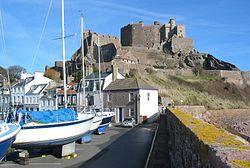Saint Martin, Jersey
| Saint Martin | ||
|---|---|---|
| Jersey parish | ||

Mont Orgueil is in the parish
|
||
|
||
 Location of Saint Martin in Jersey |
||
| Crown Dependency | Jersey, Channel Islands | |
| Government | ||
| • Connétable | Michel Le Troquer | |
| Area | ||
| • Total | 10.3 km2 (4.0 sq mi) | |
| Area rank | Ranked 6th | |
| Population (2011) | ||
| • Total | 3,763 | |
| • Density | 370/km2 (950/sq mi) | |
| Time zone | GMT | |
| • Summer (DST) | UTC+01 (UTC) | |
| Postcode district | JE3 | |
| Postcode sector | 6 | |
| Website | www |
|
Saint Martin (Jèrriais: St Martîn) is one of the twelve parishes of Jersey in the Channel Islands. Historically it was called "Saint Martin le Vieux" to distinguish it from the present day parish of Grouville (historically "Saint Martin de Grouville").
St. Martin is the only parish in Jersey not to conduct its municipal business from a Parish Hall. St. Martin has a Public Hall instead, having accepted money from the States of Jersey to provide an assembly room.
The dolmens at Le Couperon and Faldouet are among the prehistoric remains in the parish. La Pouquelaye de Faldouet features on the reverse of the Jersey ten pence coin (see coins of the Jersey pound) and was the inspiration for the poem Nomen, numen, lumen written by Victor Hugo in 1855 during his exile in Jersey.
The rock known as Le Saut Geffroy, or Geoffroy's Leap, is reputed to be an ancient place of execution where criminals were thrown into the sea. According to folklore, a man named Geffroy was condemned to be thrown into the sea. Remarkably, he survived and climbed back up the cliff face where an argument broke out among the mob of spectators. Some said that sentence had been duly carried out and that Geffroy should go free; others said that sentence had not been properly carried out. To settle the argument, and demonstrate his prowess, Geffroy dived off the rock, but perished on this occasion. Le Saut Geffroy is now preserved by the National Trust for Jersey.
The ancient castle of Mont Orgueil dominates the small harbour and village of Gorey. The castle served as the island's prison until a prison was constructed in St. Helier in the 17th century. Among agitators imprisoned there by the British government were William Prynne and John Lilburne. Until the construction of Elizabeth Castle off St. Helier at the beginning of the 17th century, Mont Orgueil was generally the residence of the Governor of Jersey.
...
Wikipedia

